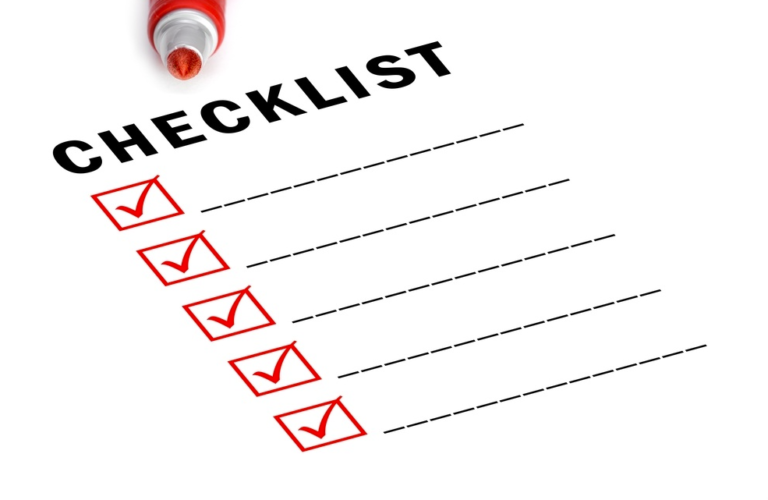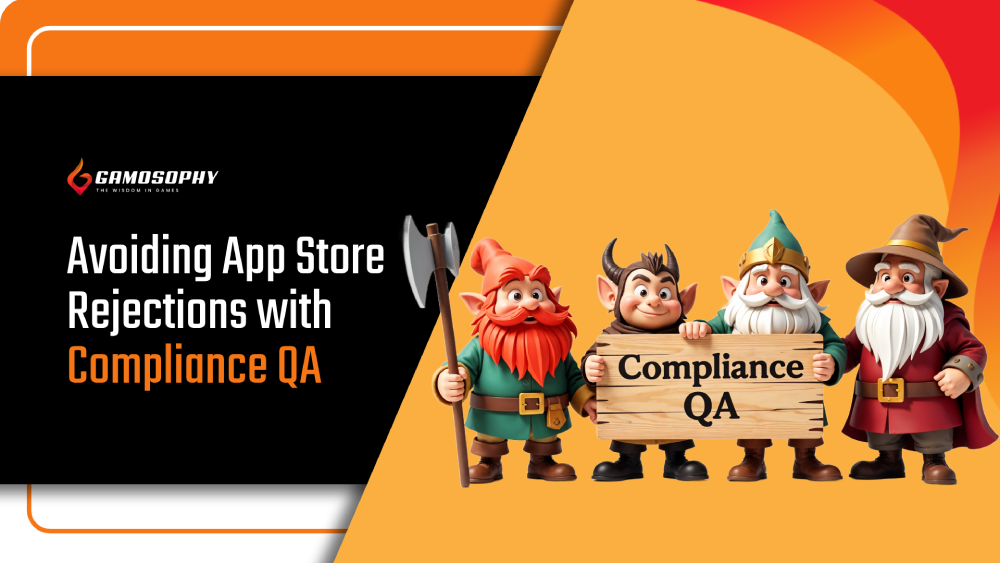App store rejections are shockingly common – Apple alone rejected 1.68 million app submissions in 2022 (macrumors.com). For indie studios, each rejection means expensive delays and wasted effort. Developers often spend weeks adding polish, only to get a terse “Guideline violation” email or a flagged compliance issue. That’s why compliance QA has become essential. Unlike basic bug testing, compliance QA double-checks your game against every platform rule (from App Store Review Guidelines to Google Play policies), ensuring nothing is overlooked before submission. By treating approval as its own checkpoint, compliance QA acts like a final submission checklist to help you avoid those costly rejections.

Why Games Get Rejected
Mobile game rejections often boil down to a few recurring issues. Performance problems are the top culprit – Apple’s transparency report attributes about 1 million rejections to performance issues alone (mobilegamer.biz). Games that crash, freeze, or lag under testing will be bounced. Other common pitfalls include:
- Crashes & Bugs: Frequent crashes or deadlocks trigger immediate rejection (Apple’s guidelines emphasize “stability” as a core rule).
- Placeholder Content: Apps containing temporary or “placeholder” text/graphics are disallowed. (In one older report, Apple explicitly noted “Apps having placeholder content are not approved”.
- Missing Privacy/Legal Info: Failure to include a privacy policy or clear data disclosures (required by both Apple and Google) gets your app flagged.
- UI/UX Flaws: Sloppy or confusing interfaces (e.g. tiny text, navigation that’s hard to use) violate App Store design rules. Apple rejects overly cluttered or unpolished UIs under its Design and Business sections (thisisglance.com).
- Content Policy Violations: Unacceptable content (like hate speech, explicit imagery, or unlicensed IP) or improper in-app purchase implementations can prompt removal.
- Metadata Issues: Inaccurate or misleading store descriptions, improper use of Apple’s keywords, or missing screenshots can all cause review delays.
- Permissions Abuse: Asking for sensors (camera, location, etc.) without clear justification breaches App Store guidelines. For example, claiming camera access but not explaining its use violates Apple’s privacy rules.
In short, many rejections don’t come from hidden rules – they come from issues developers could catch with a compliance checklist. Apple and Google publish extensive submission guidelines (see Apple’s [App Store Review Guidelines] and Google’s [Developer Policy Center]) precisely to list these traps.

obile game rejections often boil down to a few recurring issues. Performance problems are the top culprit – Apple’s transparency report attributes about 1 million rejections to performance issues alone (mobilegamer.biz). Games that crash, freeze, or lag under testing will be bounced. Other common pitfalls include:
Understanding Compliance QA
Compliance QA is a specialized form of testing focused on policy adherence rather than just bugs. Traditional functional testing asks “Does the game crash? Do the features work?” Compliance QA asks “Does the game and its submission meet all platform and legal requirements?” In practice this means scanning for things like correct content ratings, privacy disclosures, permission dialogs, network security, and more.
Where functional QA finds glitches in gameplay or UI, compliance QA cross-references platform policies. For example, console TRC/TCR checklists (Sony’s Technical Requirements Checklist, Nintendo’s Technical Certification Requirements) spell out things like how controllers should map, required reset codes, etc. Similarly, mobile compliance covers: Apple’s App Store Review Guidelines sections (Safety, Performance, Business, Design, Legal) and Google Play’s content and data policies. A QA team versed in compliance will systematically verify each rule. In porting scenarios, QA testers ensure the game “meets each platform’s requirements” so it can be published without last-minute fixes gamecloud-ltd.com.
Pre-Submission Compliance Checklist
Before hitting the “Submit” button, run through a thorough compliance checklist. Key items include:
- Crash/Performance Testing: Verify the app is stable on all target devices. Stress-test levels, simulate poor network, and check memory/battery usage. (Apple’s guidelines demand fast and bug-free performance.)
- Content & Age Ratings: Ensure the game’s content (violence, sexual references, etc.) is allowed and matches the chosen age rating. Different regions have different rules (CERO in Japan, PEGI in Europe, etc.), so use each store’s rating questionnaire accurately.
- Privacy Policy & Data Handling: Include a clear privacy policy URL in the app and on its store page. Disclose any data collection (location, contacts, camera) as required by GDPR, COPPA, and platform rules developer.apple.com | play.google.com. Apple especially enforces transparency: any personal data use must be declared with Apple’s privacy “nutrition labels.”
- Permissions & Entitlements: Only request permissions truly needed. For each (camera, mic, health data, etc.), provide a usage description string explaining why. Remove any unused or generic entitlements (like background modes) that could confuse reviewers.
- Remove Debug/Test Assets: Strip out any developer tools, logs, or placeholder art/text. Games often ship with "Debug Mode" or sample level data – make sure these are disabled or hidden in the final build. Apple explicitly cites placeholder content as grounds for rejection indiatoday.in.
- UI/UX Compliance: Check that UI elements (buttons, text) follow platform style guidelines and are fully legible. Ensure the interface adapts to all supported screen sizes/orientations. Verify localization strings and that no untranslated “TODO” text remains.
- Store Listing Review: Double-check the app’s description, keywords, icons, and screenshots for accuracy and compliance. Confirm that all promotional images follow each store’s specifications (format, no fake device frames, etc.).
- Battery/Memory Use: Ensure your game does not drain battery abnormally or hog RAM on weaker devices. Apple’s Performance rules will flag apps that crash from memory pressure. Use profiling tools to stay within reasonable performance limits.
Case Study: QA Pre-Empts a Rejection
Consider an indie studio readying its puzzle game for launch. In final QA, the team ran a compliance review and caught two critical issues before submission. First, they noticed a debug menu button still active, which could allow players to skip ads – a violation of store policy. Second, the game had no privacy policy link in its settings, even though it collected location for leaderboards. By addressing these proactively, the studio avoided a common “placeholder/debug content” rejection and the privacy violation notice. The game sailed through review on first attempt, saving weeks of delay.
Such stories are common. In another case, QA flagged that an app was using an old Android API level, failing Google’s current requirement – updating it prevented an immediate Play Store rejection. These examples show that compliance QA is not about “if we have time” but rather preventing crashes in the approval pipeline.
Google Play vs Apple: Compliance Differences
The App Store and Google Play have different review processes and emphases. Apple’s App Store is notoriously strict: every app and update is reviewed by humans against detailed rules thisisglance.com. Key checks include app performance, design polish, content appropriateness, and legal requirements. Apple vets even minor UI details – a small navigation bug or misleading icon can trigger a reject. And importantly, Apple applies the same criteria to updates as to new apps, so even patch releases can be held up.
Google Play’s process is faster and more automated thisisglance.com. New apps often go live within hours unless flagged by Google’s systems. Google’s policies focus on content safety (no gambling unless disclosed, no hate content, etc.), user data policies, and intellectual property. Because Google relies on automated scanning and a team review only when needed, some low-level UI or minor bugs may slip through initially (though these can later cause removals). However, Google is very strict about permissions declarations and background behavior, and has its own “Data Safety” requirements.
Localization Compliance: Both stores require apps to respect regional laws. For example, in the EU Apple now allows alternate app marketplaces (DMA laws), so developers must ensure any multi-store distribution is compliant. Google may require specific content in certain countries (e.g. age ratings in Google Play differ by locale). If your game is distributed globally, make sure translated texts don’t violate local content rules (some countries ban specific symbols or themes).
In practice, Google Play places more immediate focus on legal/privacy policies and machine-enforcement of rules, whereas Apple’s review will throw out apps for even minor quality issues thisisglance.com. Understanding these differences helps compliance QA tailor testing: for Apple, emphasize design guidelines and full feature visibility; for Google, emphasize policy declarations, target API levels, and accurate store metadata.
Role of the Compliance QA Team
Compliance QA is a specialized skill set. A good compliance tester stays current on changing rules: Apple updates guidelines yearly and issues urgent policy shifts (like new privacy labeling requirements), and Google tweaks its policies continuously (for kids’ content, gambling, ad tracking, etc.). By contrast, most indie developers and even generalist QA testers can’t instantly absorb all these changes. A dedicated compliance QA team bridges that gap.
Conclusion
App store compliance testing is no longer optional for serious game developers. With over one in four apps being rejected macrumors.com, a single overlooked policy can cost weeks of extra work. Compliance QA transforms the murky app submission rules into a clear testing process. By systematically checking for crashes, content issues, privacy disclosures, and more before you submit, compliance QA saves time, money, and headaches.
Moreover, external testers provide a fresh perspective. Having eyes not involved in development, they can spot ambiguity or policy gray areas without bias. For instance, a dev might think “the in-app coin purchase is clear,” but an external tester ensures the transaction flow and disclosures match platform billing rules exactly.
Ready to avoid rejections and speed your launch? Contact Gamosophy’s game QA experts for a free App Store readiness review and navigate the submission process with confidence.
FAQ
What is App Store compliance QA?
How can compliance QA help avoid app store rejections?
Compliance QA catches common pitfalls early by auditing your game against known rejection criteria. For example, it ensures your app includes required privacy disclosures, requests only necessary permissions (with clear usage descriptions), removes any placeholder content, and follows each store’s UI and content guidelines. By fixing these issues in advance, compliance QA prevents the simple mistakes that often lead to rejection.




